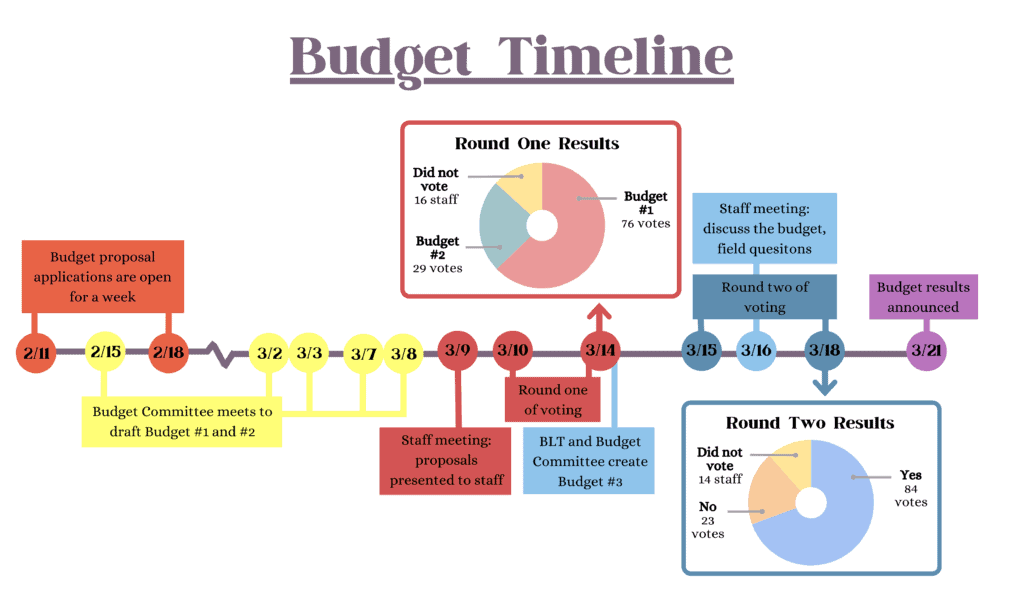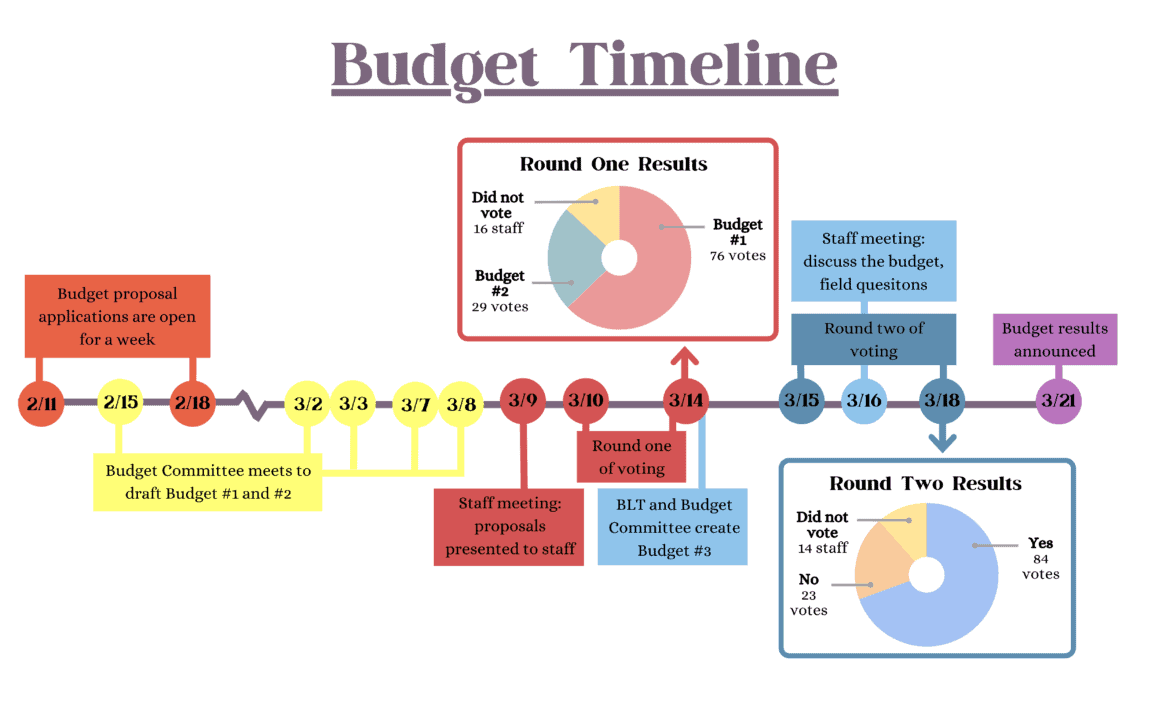
In a year characterized by decreased enrollment projections for the 2022-23 school year, approximately six RHS staff positions will be let go — or 5.8 Full Time Equivalent (FTE) positions.
These funding decisions come from Seattle Public Schools based on projected student enrollment calculations, as explained by Frederica Merrell, RHS math teacher and technical support for the Roosevelt Budget Committee.
For the 2022-23 school year, SPS has estimated Roosevelt’s building allocation at $14,245,361. Rayna Bauer, the RHS fiscal specialist, explains that this value is based on “projected estimates of total costs.”
Within this total building budget, there is a relatively small percentage set aside for staff input, formally known as the ‘discretionary fund.’ This fund is set at $324,324 for the 2022-23 school year.
“It’s a very small portion, but I feel like the fact that we’re able to have a democratic process and the staff has a voice in it is really important, even if it’s not a huge amount,” explains Maya McKenzie, Building Leadership Team (BLT) Co-Chair and Counseling Secretary.
Every year the Budget Committee — a sub-committee of the BLT — creates a proposal for how to spend the discretionary fund, and the staff votes. A two-thirds majority is necessary for a proposal to pass. With a total of 121 Seattle Education Association represented staff at Roosevelt, 81 votes in favor of the proposal are necessary.
This year, the BLT worked to prioritize SPS racial equity guidelines and the Continuous School Improvement Plan (CSIP) goals in the budgeting process. According to Jordana Hoyt, RHS social studies teacher and BLT Co-Chair, the team works to support “students furthest from educational justice.”
While in previous years Roosevelt staff were able to request funding, this year the BLT created a formal application process that asked applicants to prove how their proposal supports CSIP and racial equity goals. To do so, staff were provided with student achievement and growth data.
The application to submit a budget proposal was made available to staff Feb. 11, and proposals were due one week later. The Budget Committee received 11 proposals from staff.
The Budget Committee began meeting Mar. 2. With an application and goals provided by the BLT, the Budget Committee created a rubric that weighs proposal items through the lens of CSIP goals and educational justice, as McKenzie explains. This process created an average ranking for each proposal.
Tracy Landboe, RHS science teacher and chair of the Budget Committee, explains how the rubric attempts to limit bias as decisions focus on positions rather than individual colleagues. In her first year being involved in the budgeting process, Landboe says, “I can’t imagine doing it without the tool [rubric] we had this year, to be honest.”
The BLT also requested that the Budget Committee create two proposals — a shift from the traditional practice of just one proposal on which staff vote for or against. “So that’s double the work in a short time span,” says Landboe.
In regard to the two proposals created, Hoyt says, “Unfortunately, I think the second proposal was very rushed because of timing.” However, Hoyt goes on to explain the short timeline as a part of a larger issue: “It’s a very problematic timeline because it can feel very rushed and that’s really on the district’s policy about it.”
Using the ranking born of the rubric, two proposals were created for the first round of voting. “The first budget was just trying to fund as many of the ranked items as we could,” explains Landboe. Once the top six items were funded, the discretionary fund couldn’t afford any more costly items in the ranking. So more affordable, lower ranked items were selected. This budget included funding for a 0.6 FTE position for an Academic Intervention Specialist (AIS).
For the second budget proposal, most funded items remained the same. However, funding for a 0.6 AIS was replaced by a 1.0 FTE position for a Math Instructional Assistant (MIA) in algebra classes. Both items cost approximately the same.
An AIS intervenes to support students who may be struggling academically or behaviorally. An MIA offers academic support in algebra classes.
On Mar. 9, both proposals were presented to the staff, and round one of voting began the following day. Votes closed and were tallied on Mar. 14. Budget Proposal 1 had won 76 votes, while Proposal 2 had won 29 votes. Proposal 1 was five votes short of approval.
Shortly after, the Budget Committee and the BLT reconvened to adjust Proposal 1. Minor adjustments were made: funding for supplies was moved to support a 0.2 unrestricted FTE, meaning administration can use this funding for any staff position they deem necessary. Landboe explains that this request came from administration, “because the administration knows we’re going to lose a lot of FTE.”
Other items funded in all versions of the budget include a supplemental 0.4 FTE for the Athletic Director and Activities Coordinator, 0.5 FTE for a part-time Career Center Specialist, and funding for a library helper and extended homework center hours in the library.
On Mar. 15, a second round of voting opened for the adjusted third proposal. Three days later, 84 votes had been cast in its favor, and the necessary two-thirds majority had been met.
If round two of voting hadn’t won a two-thirds majority, the discretionary fund would have been passed to the administration to spend at their discretion.
Looking back at the short budgeting season, Merrell says, “I just hope everybody appreciates the work of the budget committee … it’s hard work and it’s stressful, and you never have enough money to do all the things you want to do.”



